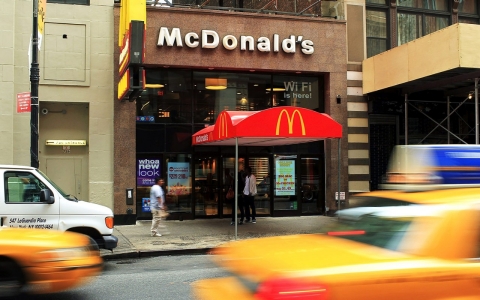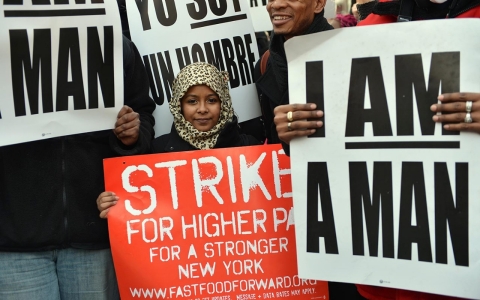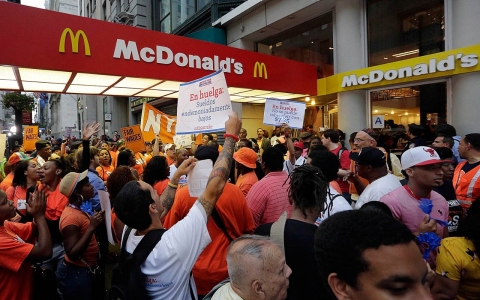The majority of American families on public assistance or Medicaid are headed by at least one full-time worker, according to a report released Monday by the University of California at Berkeley’s Center for Labor Research and Education.
Researchers who analyzed annual state and federal spending on public assistance programs — including food stamps, Medicaid, Temporary Aid to Needy Families and the earned income tax credit — found that more than 56 percent of that spending goes to working families.
In other words, employers, such fast-food restaurants, are paying their employees so little that they must rely on government assistance to make ends meet. In total, these employees seek an estimated $153 billion in public assistance each year, according to the report (PDF).
“When companies pay too little for workers to provide for their families, workers rely on public assistance programs to meet their basic needs,” Ken Jacobs, chair of the Center for Labor Research and Education and co-author of the report, said in a release. “This creates significant cost to the states.”
The researchers looked at data from public assistance programs in 2009 to 2010 and from the Bureau of Labor Statistics’ Current Population Survey from 2010 to 2012. In crunching the numbers, they found that 52 percent of state public assistance goes to working families, which they defined as having at least one person in the household working for at least 10 hours a week and for at least 27 weeks a year.
That’s at a cost of $3.7 billion for public assistance programs in California, $3.3 billion in New York and $2 billion in Texas, according to the report.
The report also said that wage growth stagnated from 2003 to 2013 for the lowest 70 percent of all earners, while the amount of those earners who received health insurance through their jobs decreased from 67 percent to 58 percent during the same time period.
The need for public assistance wasn’t limited to fast-food workers, who have in recent years launched increasingly visible campaigns to demand a $15 per hour minimum wage and benefits. While slightly more than half of fast-food workers rely on assistance programs, the report said, child care and home health care workers do so 46 percent and 48 percent of the time, respectively. Some 25 percent of adjunct college professors also depend on public assistance programs.
The authors of the report urged employers to pay their workers higher salaries and provide health-care benefits, which would save state and federal governments significant amounts of money.
“Raising wages would lift working families out of poverty and allow all levels of government to better target how our tax dollars are used,” Jacobs said.
Fast-food workers on Wednesday will be joined by a number of low-wage workers from a range of other fields, including airport staff and Walmart employees, to protest in New York City for a living wage.
In lieu of action from corporations, several U.S. cities and states have taken the matter into their own hands by raising the minimum wage. Some 20 states approved minimum wage raises that took effect at the start of 2015. Seattle voted to raise its minimum wage to $15 an hour, as did San Francisco. And in 2016, California will begin publishing the names of companies with the most employees relying on Medicaid for health insurance coverage.

Impact will be limited because it affects only workers at 1,500 restaurants owned by McDonald's and not franchisees

A lawsuit brought by the International Franchise Association could set precedent for how states regulate chains

Analysis: Racial justice groups provide a boost to Walmart, fast-food campaigns

In largest planned protests to date, fast-food workers to escalate tactics and embrace beleaguered home care workers

Workers kick off early-morning strikes, asking for higher minimum wage and the ability to unionize






Error
Sorry, your comment was not saved due to a technical problem. Please try again later or using a different browser.